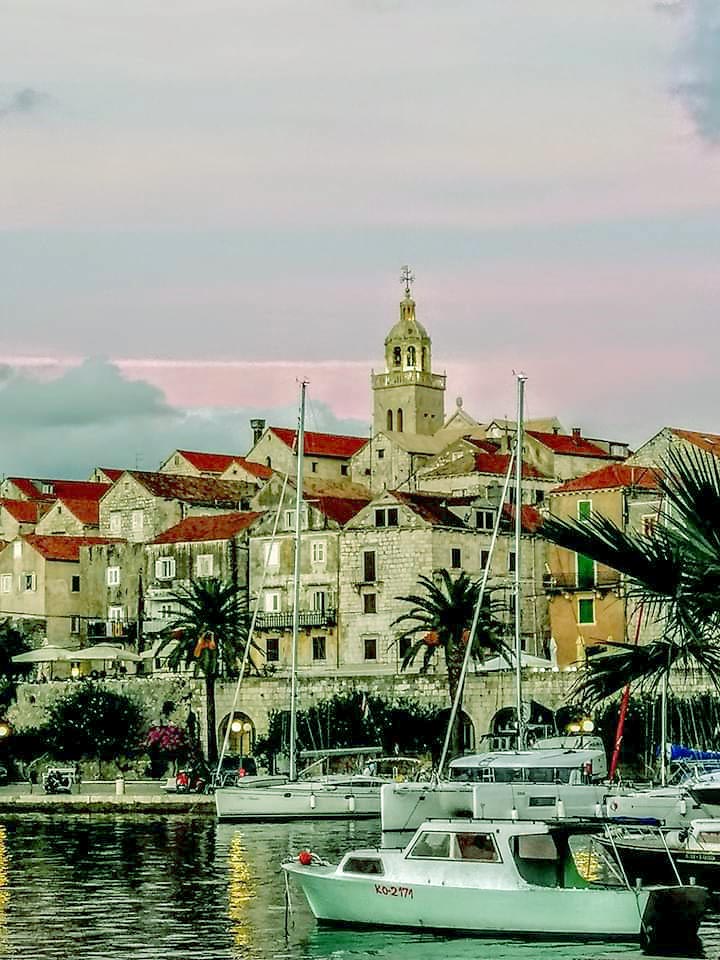“The greenest, most independent and most interesting of Croatia’s 1,000 or so islands, Korcula was a favorite Greek holiday spot over 2,000 years ago.”
( The Observer – 20 Paradise islands – Korcula is No.9 )

KORCULA was first settled by the Greeks, who gave it the name Korkyra Melaina or “Black Corfu” for its dark and densely wooded appearance. Even now, it’s one of the greenest of the Adriatic islands, and one of the most popular. The island’s main settlement is Korcula Town, and the rest of the island, although beautifully wild, lacks any real centers. The main coastal ferry docks at Korcula Town harbor. In addition, local ferries travel daily between Split and Vela Luka at the western end of Korcula island, from where there’s a connecting bus service to Korcula Town. There’s also a bus service from Dubrovnik, which crosses the narrow stretch of water dividing the island from the mainland by ferry from Orebic.
KORCULA TOWN sits on a beetle-shaped hump of land, a medieval walled city ribbed with a series of narrow streets that branch off the spine of the main street like the veins of a leaf. The Venetians first arrived here in the eleventh century, and stayed, on and off, for nearly eight centuries. Their influence is particularly evident in Korcula’s old town, which huddles around the Cathedral of St Mark, squeezed into a space between the buildings that roughly passes for the main square. The cathedral facade is decorated with a gorgeous fluted rose window and a bizarre cornice frilled with strange gargoyles. The interior, reached through a door framed by statues of Adam and Eve, is one of the loveliest in the region, a curious mixture of styles, ranging from the Gothic forms of the nave to the Renaissance northern aisle, tacked on in the sixteenth century. The best of the church’s treasures have been removed to the Bishop’s Treasury (July & August: daily 10 am -noon & 5–7 pm; at other times enquire at the tourist office; 10kn), a couple of doors down. This small collection of fine and sacral art is one of the best in the country, with an exquisite set of paintings, including a striking Portrait of a Man by Carpaccio and a Leonardo da Vinci sketch of a soldier wearing a costume bearing a striking resemblance to that of the Moreška dancers. Opposite the treasury, a former Venetian palace holds the Town Museum (July & August daily 9am–1pm & 5–7pm; rest of year Mon–Sat 9am–1pm; 10kn), whose more modest display contains a plaster cast of a fourth-century BC Greek tablet from Lumbarda – the earliest evidence of civilization on Korcula. Close by the main square, down a turning to the right, is another remnant from Venetian times, the so-called House of Marco Polo (summer daily 10am–1pm & 5–7pm; 10kn). Korcula claims to be the birthplace of Marco Polo, although it seems unlikely that he had any connection with this seventeenth-century house, which these days are little more than an empty shell with some terrible twentieth-century prints.
About Korcula, as it says in one of the tourist brochures:
Korcula – Nearly 200 unspoiled coves and beaches.
Korcula is an attractive island off the Adriatic coast of Croatia. The island has nearly 200 unspoilt coves and beaches, lush wooded valleys, and many vineyards. A holiday to Korcula benefits from an average of 3,000 hours of sunshine each year but the countryside is lush and ideal for Mediterranean plants. Korcula – Perfect for swimming and underwater diving.
Korcula is ideal for an active holiday with some excellent walks through pine woods and many Stone Age caves. Korcula has clean beaches, numerous unspoiled coves, and an azure blue sea. The island is perfect for swimming and underwater diving. Windsurfing and sailing are also available.